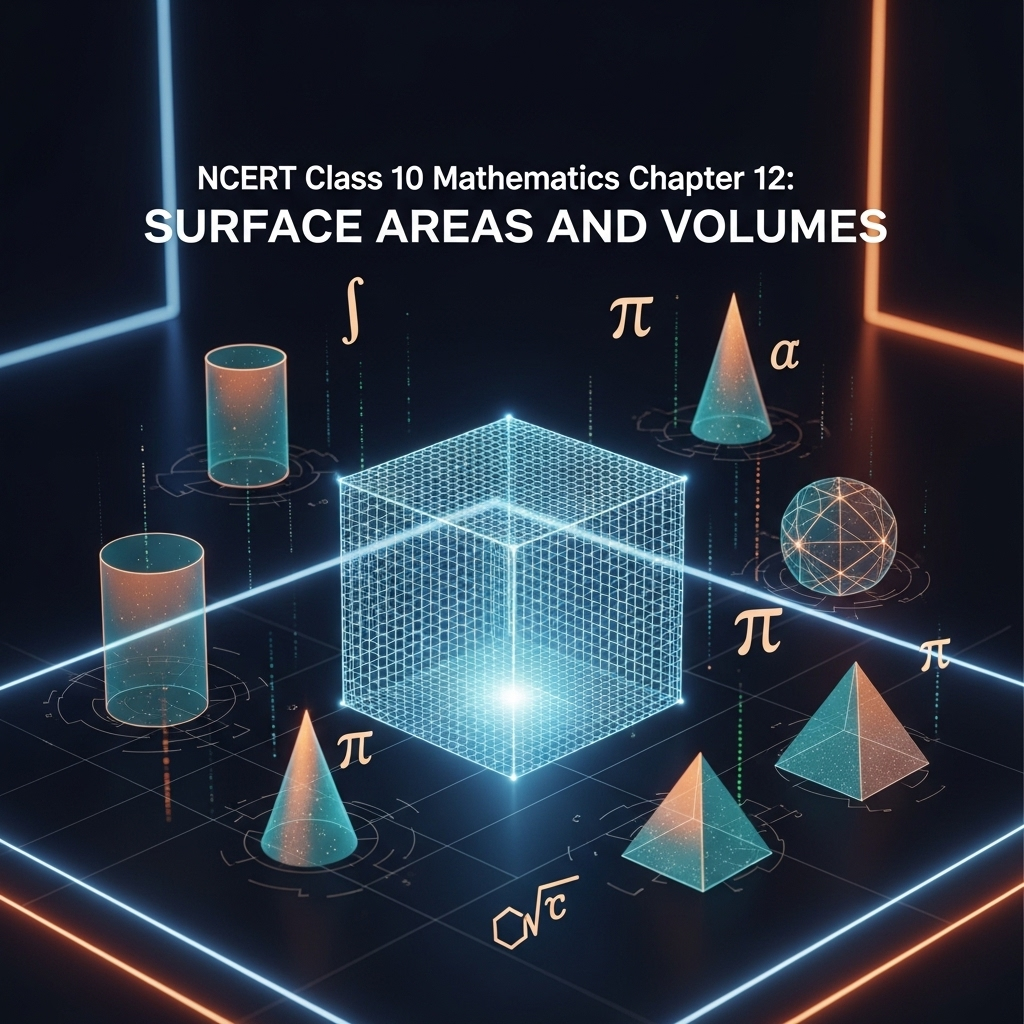Complete Solutions and Summary of Surface Areas and Volumes – NCERT Class 10, Mathematics, Chapter 12 – Summary, Questions, Answers, Extra Questions
Comprehensive summary and explanation of Chapter 12 'Surface Areas and Volumes', covering surface area and volume calculations of various solids including cubes, cuboids, cylinders, cones, spheres, and hemispheres, combined solids, formulas for total and curved surface areas, volume addition for composite solids, practical applications, and fully solved NCERT questions with extra practice problems.
Updated: 1 month ago
Categories: NCERT, Class X, Mathematics, Summary, Extra Questions, Surface Areas, Volumes, Solids, Geometry, Composite Solids, Chapter 12

Surface Areas and Volumes
Chapter 12: Mathematics - Ultimate Study Guide | NCERT Class 10 Notes, Questions, Examples & Quiz 2025
Full Chapter Summary & Detailed Notes - Surface Areas and Volumes Class 10 NCERT
Overview & Key Concepts
- Chapter Goal: Learn to calculate surface areas and volumes of combined solids like cuboid+hemisphere, cone+cylinder. Exam Focus: TSA, CSA, volumes of combinations. 2025 Updates: Real-life applications like tents, bird-baths. Fun Fact: Ancient Greeks studied spheres, volumes. Core Idea: Break complex solids into basics. Real-World: Trucks, test tubes, toys, bird-baths, sheds.
- Wider Scope: Engineering, architecture; capacity calculations.
12.1 Introduction
- Recall basics: Cuboid, cone, cylinder, sphere from Class IX (Fig. 12.1).
- Combinations in life: Truck container (cylinder + 2 hemispheres, Fig. 12.2), test tube (cylinder + hemisphere, Fig. 12.3).
- Buildings, monuments as combinations.
- Challenge: Classify, find SA/volumes/capacities.
- Detailed Discussion: Break into parts; SA excludes joined faces, volume sums. Example: Container SA = CSA cylinder + 2 CSA hemispheres.
- Importance: Practical problems like painting, capacity.
- Historical Note: Archimedes' sphere-cylinder relation.
12.2 Surface Area of a Combination of Solids
- Break into basics; SA = sum visible surfaces.
- Example: Container (Fig. 12.4) TSA = CSA cylinder + 2 CSA hemispheres.
- Toy (cone + hemisphere, Fig. 12.5) TSA = CSA cone + CSA hemisphere (base excluded).
- Detailed Discussion: Match radii; subtract hidden areas. For cone on hemisphere, smooth surface, no base SA.
- Formulas Recap: CSA cylinder 2πrh, hemisphere 2πr², cone πrl.
- Common Mistakes: Forgetting subtract joined parts.
Example 1: Top (Lattu) SA
- Height 5 cm, diameter 3.5 cm; cone h=3.25 cm, l≈3.7 cm.
- TSA = CSA hemisphere + CSA cone = (πr²) + πrl ≈39.6 cm².
- Detailed Steps: r=1.75 cm, CSA hemisphere = 2πr²/2 = πr² (curved only? Book 2πr²/2=πr²). Wait, hemisphere CSA=2πr², but for toy external curved.
- Verification: Calculations with π=22/7.
- Extension: If base painted, add πr².
Example 2: Decorative Block SA
- Cube 5 cm, hemisphere diameter 4.2 cm.
- TSA = 6*25 - πr² + 2πr² =150 + πr² ≈163.86 cm².
- Detailed Steps: Subtract base hemisphere from cube TSA, add CSA hemisphere.
- Verification: r=2.1 cm, π=22/7.
- Extension: If depression inside, different.
Example 3: Toy Rocket SA
- Height 26 cm, cone h=6 cm, diameters 5 cm cone, 3 cm cylinder.
- Orange: CSA cone + π(r² - r'²) ≈63.585 cm².
- Yellow: CSA cylinder + πr'² ≈195.465 cm².
- Detailed Steps: Slant l=√(2.5²+6²)=6.5 cm; ring area since cone base larger.
- Verification: π=3.14.
- Extension: Total SA if uniform color.
Example 4: Bird-Bath SA
- Cylinder h=1.45 m, r=0.3 m.
- TSA = 2πr(h + r) =3.3 m².
- Detailed Steps: CSA cylinder + CSA hemisphere (depression external? Book as external).
- Verification: π=22/7.
- Extension: Volume of water.
Exercise 12.1
- 9 problems: Joined cubes, vessel, toy, block, depression, capsule, tent, cavity, article.
- Detailed Discussion: Apply combination SA; π=22/7 unless otherwise.
- Common Types: Mounted, surmounted, hollowed, scooped.
12.3 Volume of a Combination of Solids
- Volume = sum constituent volumes (no disappearance).
- Example: Shed (cuboid + half cylinder, Fig. 12.12) volume = cuboid + ½ cylinder.
- Detailed Discussion: Unlike SA, add fully; capacities subtract occupied.
- Formulas Recap: Cuboid lwh, cylinder πr²h, hemisphere 2/3 πr³.
- Common Mistakes: Forgetting half or depressions.
Example 5: Shed Volume
- Base 7x15 m, cuboid h=8 m; volume ≈1128.75 m³.
- Air: Subtract machinery 300 m³, workers 1.6 m³ ≈827.15 m³.
- Detailed Steps: Half cylinder r=3.5 m, h=15 m.
- Verification: π=22/7.
- Extension: If full cylinder.
Example 6: Juice Glass Capacity
- Diameter 5 cm, h=10 cm; apparent 196.25 cm³, actual 163.54 cm³.
- Detailed Steps: Subtract hemisphere volume 2/3 πr³ ≈32.71 cm³.
- Verification: π=3.14.
- Extension: If cone depression.
Example 7: Toy Volume Difference
- Cone h=2 cm, diameter 4 cm; toy volume 25.12 cm³.
- Cylinder difference 25.12 cm³.
- Detailed Steps: Toy = 2/3 πr³ + 1/3 πr²h; cylinder πr²(4).
- Verification: π=3.14.
- Extension: SA of toy.
Exercise 12.2
- 8 problems: Cone+hemisphere, model, gulab jamun, pen stand, vessel, pole, cone+hemisphere in cylinder, glass vessel.
- Detailed Discussion: Volumes add; subtract for cavities, displacements.
- Common Types: Standing, surmounted, filled, hollowed.
12.4 Summary
- SA: Combine basics, subtract hidden.
- Volume: Sum basics.
- Detailed Discussion: Key for exams; practice combinations.
Why This Guide Stands Out
Complete chapter coverage: Notes, examples, Q&A (all NCERT + extras), quiz. Student-centric, exam-ready for 2025. Free & ad-free.
Key Themes & Tips
- Combinations: Break down.
- SA: Curved + adjusted bases.
- Volume: Sum parts.
- Tip: Match radii; use π=22/7; positive values.
Exam Case Studies
Word problems on tents, vessels, toys; volumes displaced.
Project & Group Ideas
- Model combinations; calculate SA/volume.
Group Discussions
No forum posts available.


